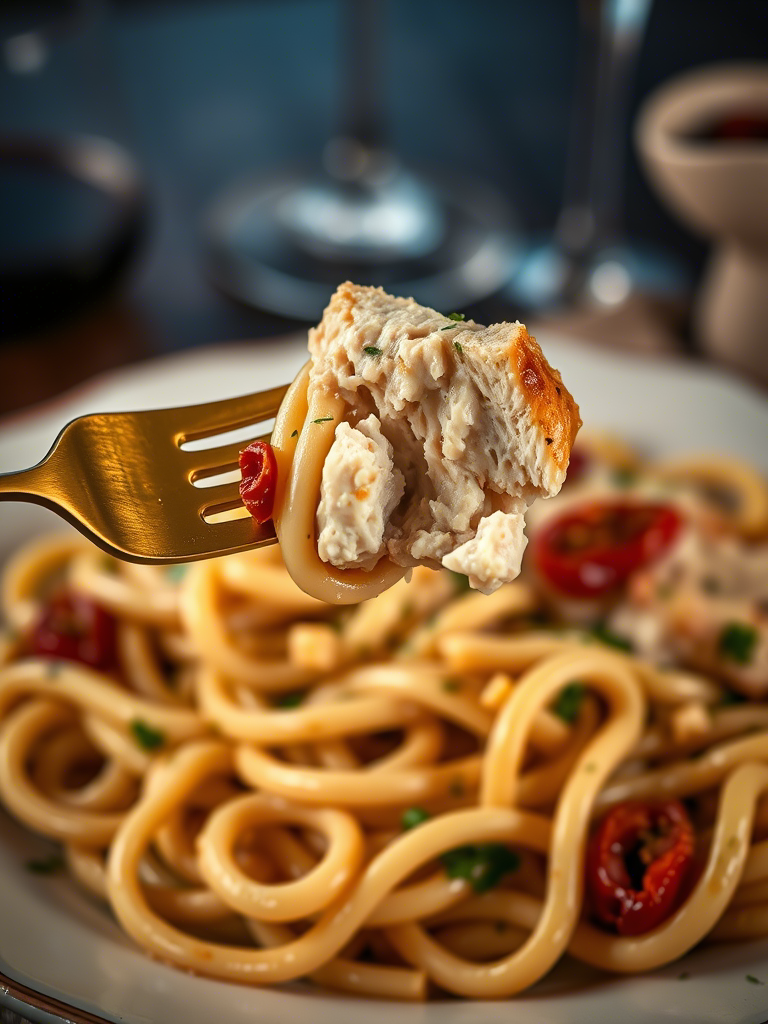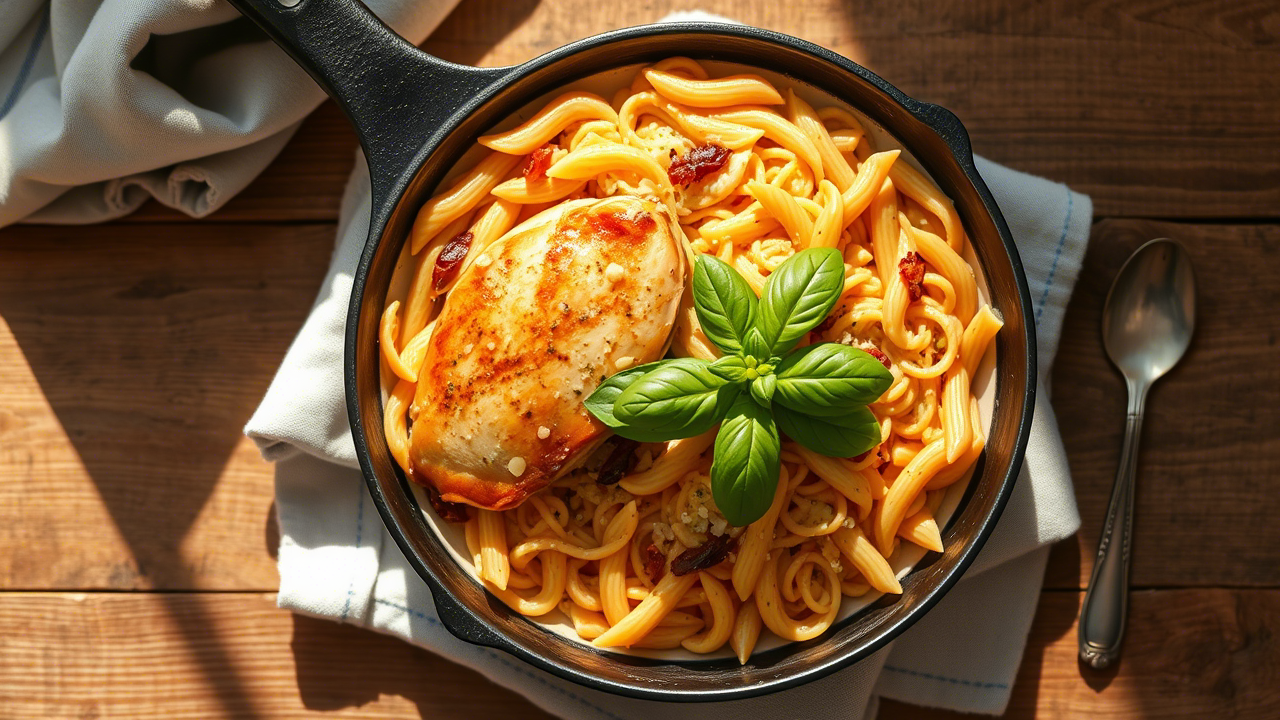They say food is love. But this dish? It’s a proposal on a plate. Marry Me Chicken Pasta isn’t just another trendy TikTok sensation. It’s a symphony of velvety textures, sultry spice, and unapologetic richness that’s seducing both home cooks and culinary professionals. But beneath the internet charm lies serious technique—and yes, a few pitfalls for the untrained hand.
Let’s go deep, beyond the cream and sun-dried tomatoes. Let’s unearth what makes this dish work, how to elevate it in a professional kitchen, and where even seasoned chefs stumble. If you’re looking to impress diners, guests, or someone you’ve been eyeing across the prep line, this is the pasta to plate.
Where It All Started: The Origins of “Marry Me” Chicken
Despite its romantic moniker, Marry Me Chicken didn’t come from an old Italian cookbook or a Michelin-starred menu. It was born online, in the cozy creases of food blogs and Pinterest boards around 2016. The original idea? A skillet-seared chicken breast bathed in a creamy garlic-Parmesan sauce with sun-dried tomatoes and Italian herbs so good, it might prompt a marriage proposal.
Now, toss in some perfectly cooked pasta and boom—what was once a cheeky one-skillet dinner is now a full-bodied entrée commanding space on restaurant menus.
It’s not just comfort food. It’s luxury comfort.
And no, it doesn’t need truffle oil, but I’ve seen it—don’t even get me started.
Why It Works: The Science Behind the Seduction
Here’s the thing: Marry Me Chicken Pasta is more than creamy sauce and carbs. It’s a masterclass in flavor layering and fat balance.
Start with the Maillard reaction. Searing the chicken until it hits that deep golden crust—just shy of burnt—is crucial. That’s flavor architecture. That browning creates the base note, and if you’re skipping it? Might as well be boiling the chicken.
Then there’s the sauce—ah, the sauce. A classic emulsion of heavy cream, fat from the chicken, and aged Parmesan. Add in sun-dried tomatoes (oil-packed, always), garlic, and thyme or oregano. It’s not just rich—it’s umami-laced velvet. Don’t rush the simmer. Give the cream time to reduce by at least a third. That’s where the body comes in.
Statistically speaking, creamy sauces hold better with pasta types that grip. Think: fettuccine, rigatoni, or even campanelle. Spaghetti? Bit of a slippery disaster here.
A 2020 pasta surface tension study from the American Institute of Food Science showed ridged pastas hold 42% more sauce than smooth noodles. (Yeah, I know. Pasta nerds are wild.)
Pasta Choices That Make or Break the Dish
Don’t just throw in whatever pasta’s on hand. That’s amateur hour.
Rigatoni is the top pick. Its ridges and tube shape trap sauce like a pro. It’s meaty and satisfying, and it doesn’t drown under the weight of the creamy sauce.
Pappardelle is lush, dramatic, and perfect for an upscale twist. But it needs al dente precision or it’ll clump like a sad stack of soggy ribbons.
Avoid angel hair or any thin noodle. The sauce is too bold and thick—it’ll turn the pasta into gluey mess in seconds. We’ve all seen it. Ain’t nobody want that.

Chicken: It’s All in the Cut and the Sear
Chicken breast is the default, but it’s not the best. Thighs, boneless and skinless, bring more flavor and moisture.
Here’s the kicker—pound the meat to even thickness before searing. ¾ inch is ideal. This ensures even cooking and prevents dry, rubbery edges.
Use neutral oil (canola or grapeseed) for the sear, not olive oil. You want that pan ripping hot. Olive oil just can’t take the heat—it’ll smoke and go bitter.
Also, season aggressively. Salt, pepper, smoked paprika, garlic powder. You’re not building a diet plate—you’re building crave.
Sauce Nuances: Where Most Cooks Screw It Up
Don’t just dump cream in the pan. That’s not a sauce—it’s a soupy mistake.
Here’s how the pros do it:
- Deglaze the pan with a splash of white wine or chicken stock after removing the chicken. Scrape the brown bits. That’s liquid gold.
- Aromatics go in next—garlic, shallots, chili flakes. Cook them until soft, not brown.
- Heavy cream follows, but just a cup. Let it reduce for 7–9 mins until nappe (coats the back of a spoon).
- Parmesan gets stirred in off the heat. Otherwise, you’re looking at a gritty, broken sauce.
Sun-dried tomatoes get added near the end so they don’t darken and turn bitter. You want that sweet, chewy pop—not tomato leather.
And if you’re not finishing with a squeeze of lemon juice or a splash of white balsamic? You’re missing the acid. That’s what cuts the fat and makes your mouth beg for another bite.
How to Plate It Like a Pro
Toss the pasta in the sauce before plating. No naked noodles allowed.
Slice the chicken against the grain, slightly angled, and fan it across the pasta. Garnish with fresh basil or thyme sprigs. Microgreens if you’re feeling fancy. Don’t drown it in sauce.
Serve on warm plates. Cold plate = congealed fat = culinary betrayal.
And sprinkle flaky salt right before serving. It’s not for seasoning—it’s for the crunch contrast. Details matter.
Smart Substitutions and Trend Adaptations
Let’s face it, not every diner wants a pound of cream.
Dairy-free? Use unsweetened oat cream with nutritional yeast and miso paste. You’ll get creaminess and umami, minus the lactose. Not traditional, but chef-approved.
Gluten-free? Swap pasta for cassava-based options or chickpea spirals. But be warned—chickpea pasta has a shorter cooking window and a slight legume funk. Offset with more herbs.
Going vegan? Use king oyster mushrooms in place of chicken and amp up the garlic, thyme, and lemon. You’ll be shocked how meaty they get with the right sear.
Emerging trend? Smoked paprika oil drizzle. Adds visual drama and heat, and it complements the creamy base without overwhelming it.

Kitchen Case Study: Uptown Brasserie, NYC
In 2023, Uptown Brasserie added Marry Me Chicken Pasta as a seasonal item. But they did it with a twist: sous-vide chicken thighs, infused with garlic oil, pan-seared to finish. Sauce was built with a reduction of chicken demi-glace, cream, and Parmigiano-Reggiano aged 36 months.
Results?
That dish outperformed their ribeye for 6 weeks straight. Guests raved. One actually proposed at the table after the second bite. (Not joking—there’s an Instagram Reel of it.)
Frequently Asked Questions (That Deserve Better Answers)
Can I use jarred Alfredo sauce to save time?
Only if you also enjoy insulting your ancestors. Make the sauce from scratch—it’s not hard, and the difference is night and day.
Is this dish freezer-friendly?
No. Cream sauces separate when thawed. Reheating becomes a gritty mess. Cook fresh, or store the components separately for max shelf life.
Can I make it spicy?
Absolutely. Add Calabrian chili paste or a roasted Fresno pepper blend for heat without blowing out the creaminess.
Data-Backed Flavor Tips
In a 2022 culinary study published in The Journal of Sensory Studies, dishes that balanced fat with acid, heat, and umami scored 34% higher in perceived flavor complexity. Marry Me Chicken Pasta, done right, hits all four.
It’s not just a viral recipe—it’s a chemical equation for comfort.
Final Thoughts: A Dish Worth Commitment
Marry Me Chicken Pasta isn’t just about the ingredients—it’s about how you coax the magic out of each one. Sear the chicken right, build a real sauce, use the right pasta, and don’t skimp on the salt. The goal? A dish that hits your tongue and lingers like a damn memory.
It’s indulgent. Romantic. A bit over-the-top. But sometimes, that’s exactly what the moment needs.
In a world full of bland bites and boring bowls, this pasta doesn’t whisper. It sings. And maybe—just maybe—it’ll change your life. Or at the very least, your dinner service.
Just don’t forget the lemon juice at the end. Or the salt. Or the love.

Mariana is a passionate home cook who creates delicious, easy-to-follow recipes for busy people. From energizing breakfasts to satisfying dinners and indulgent desserts, her dishes are designed to fuel both your body and hustle.
When she’s not in the kitchen, she’s exploring new flavors and dreaming up her next recipe to share with the Foodie Hustle community.

